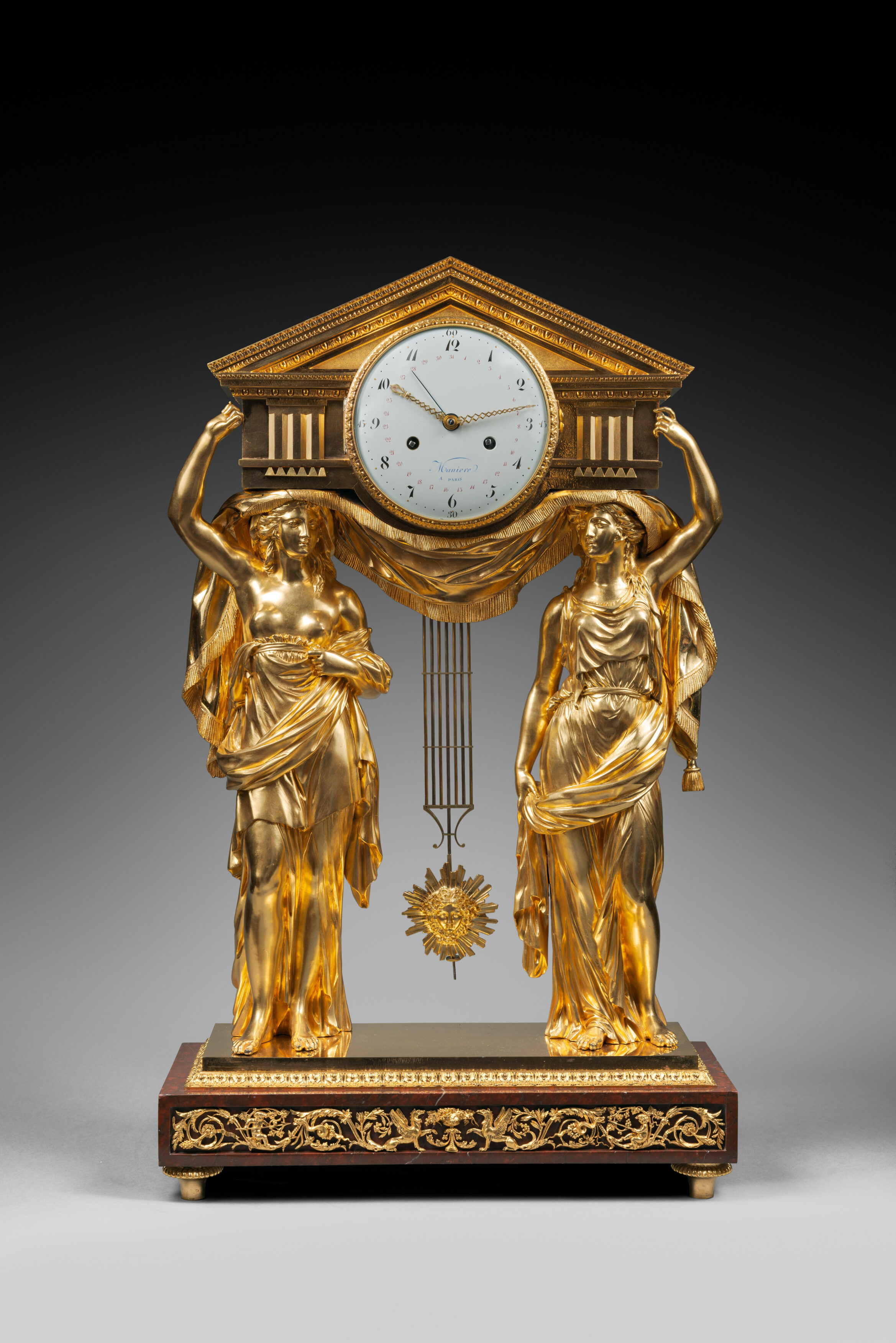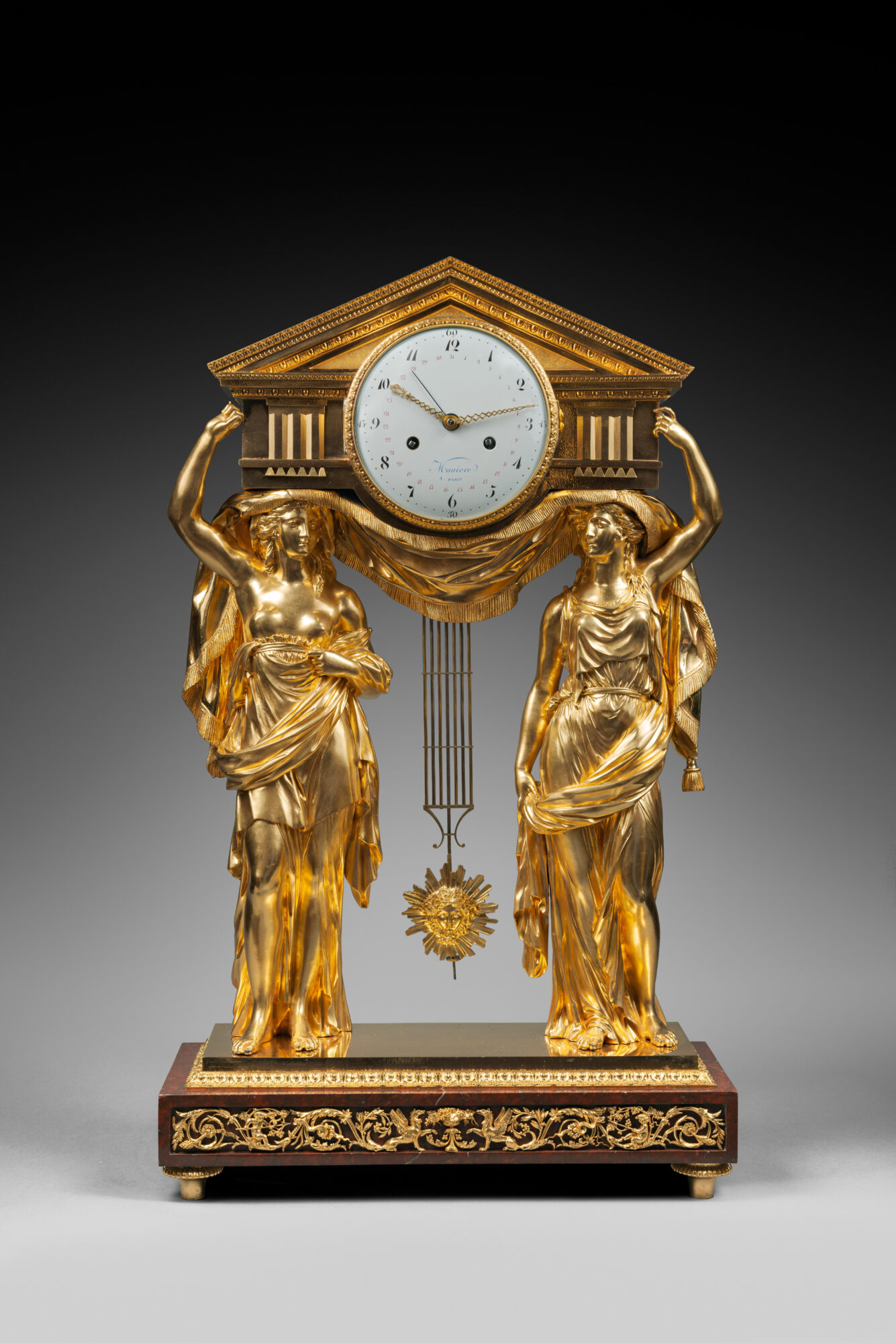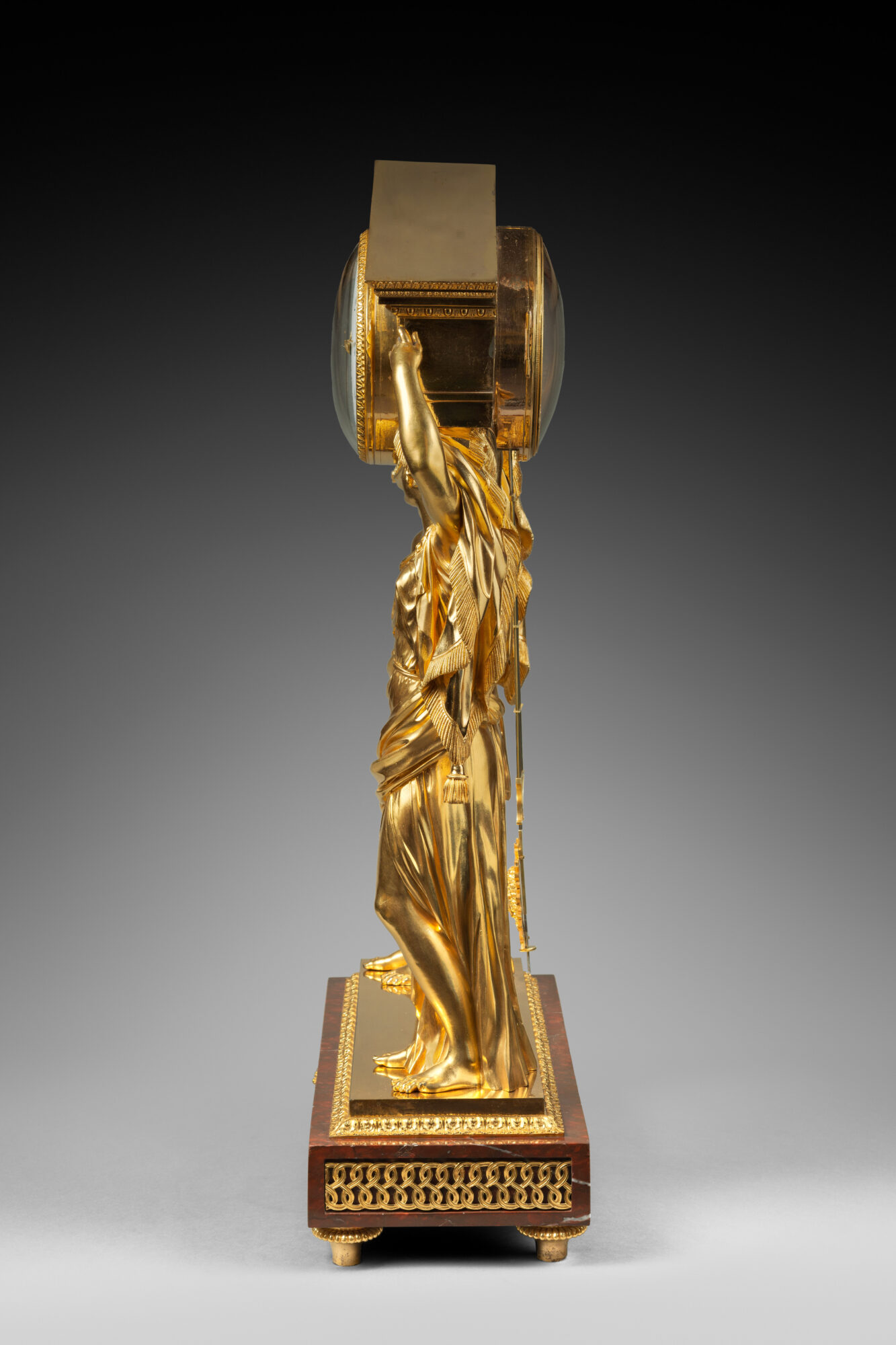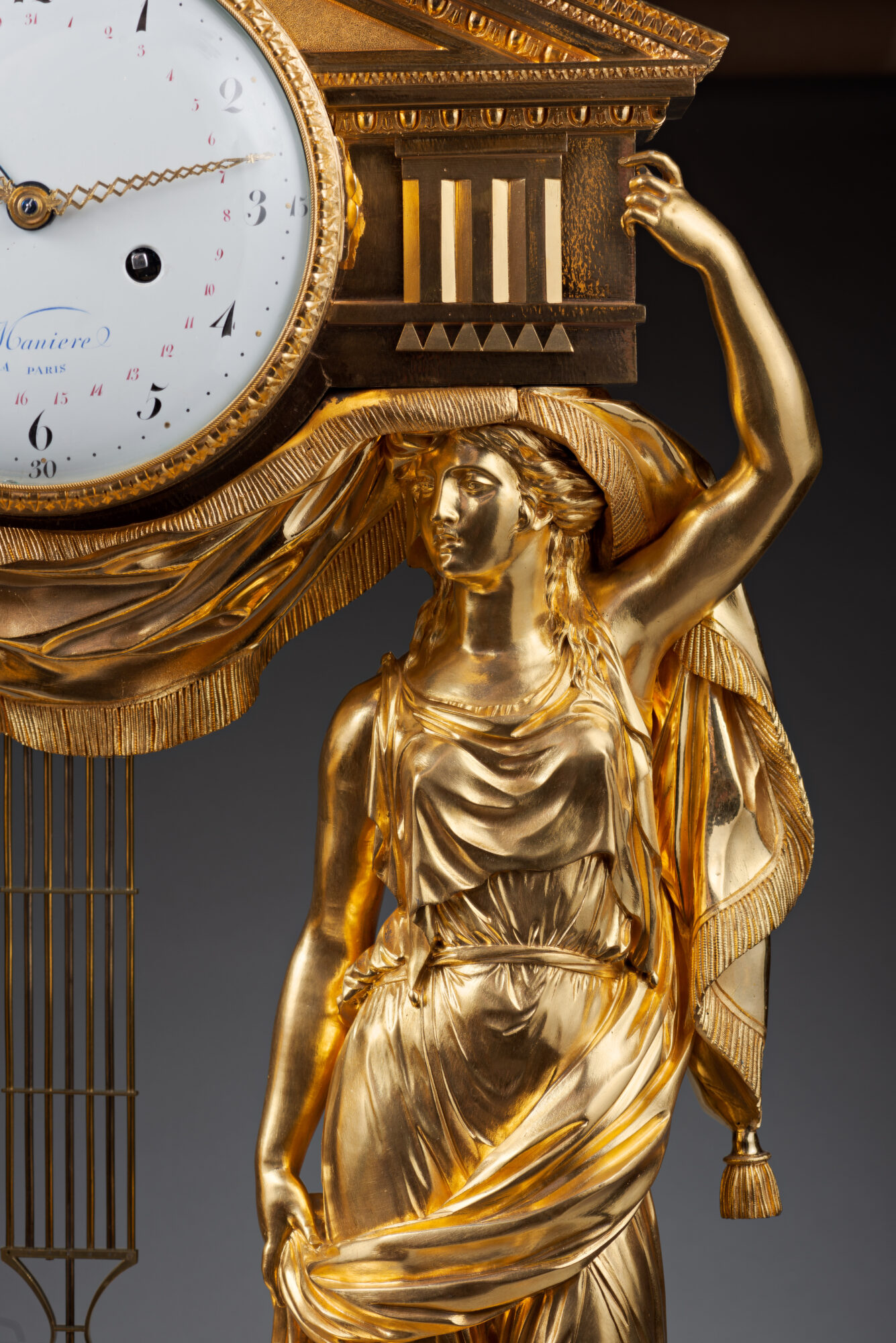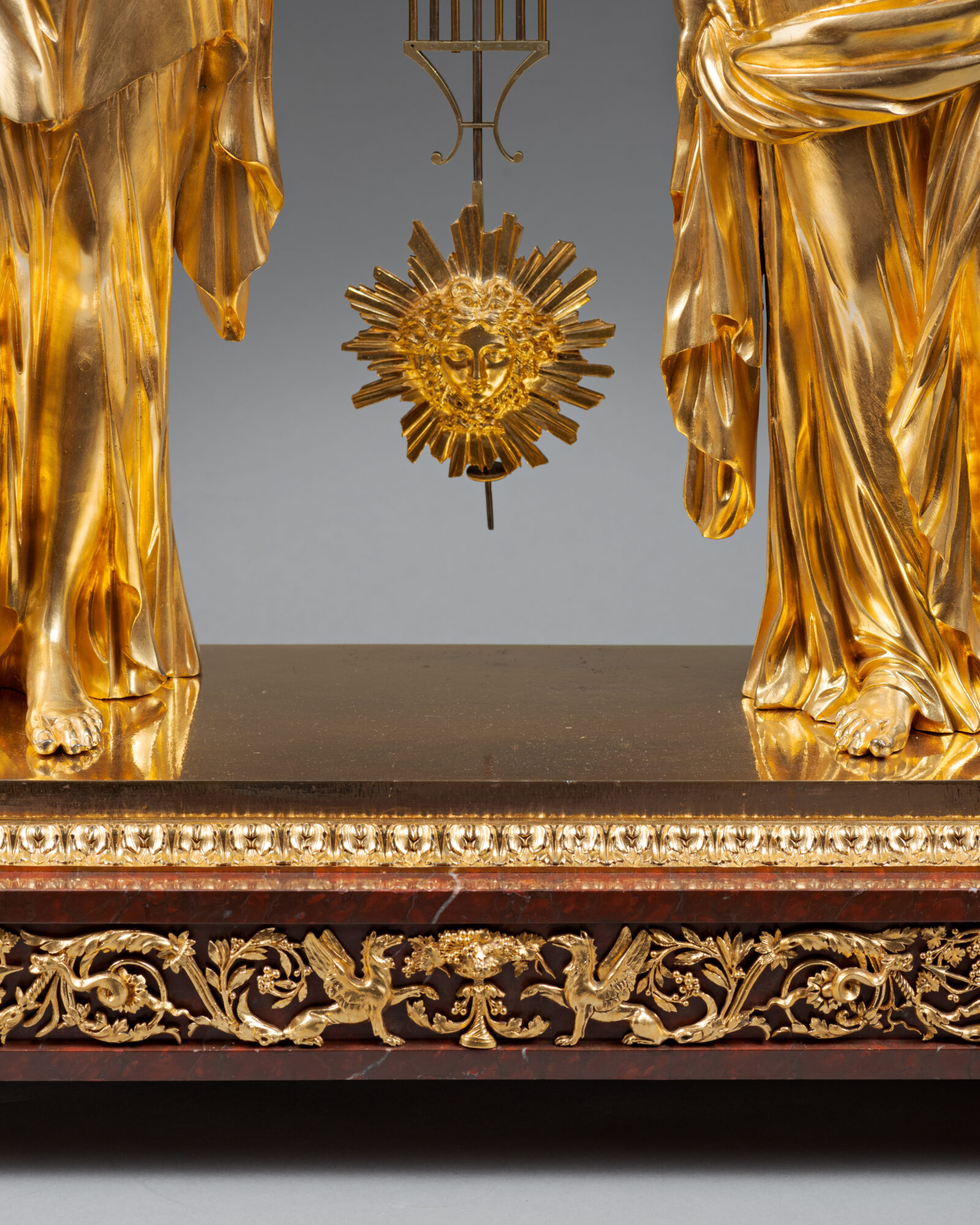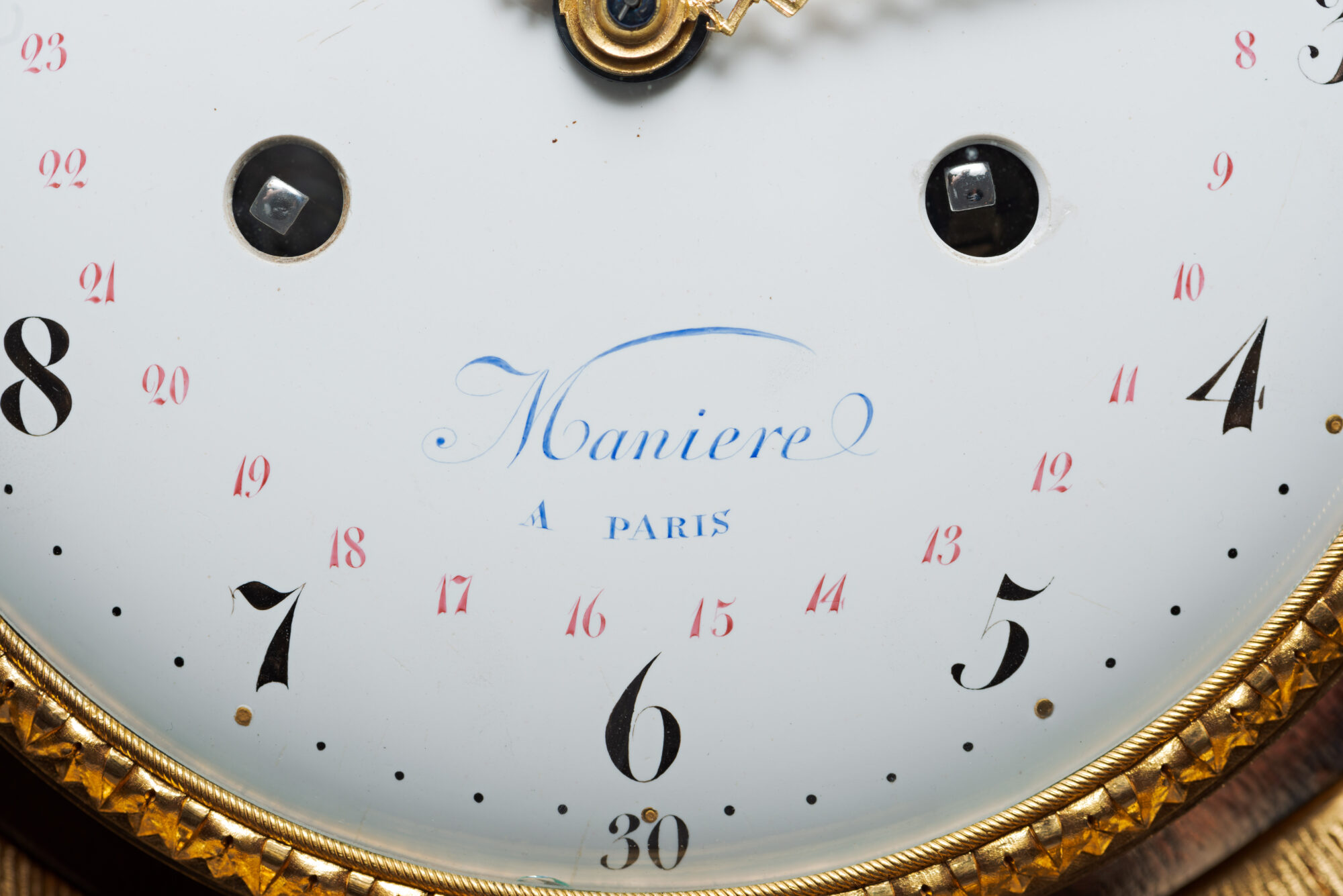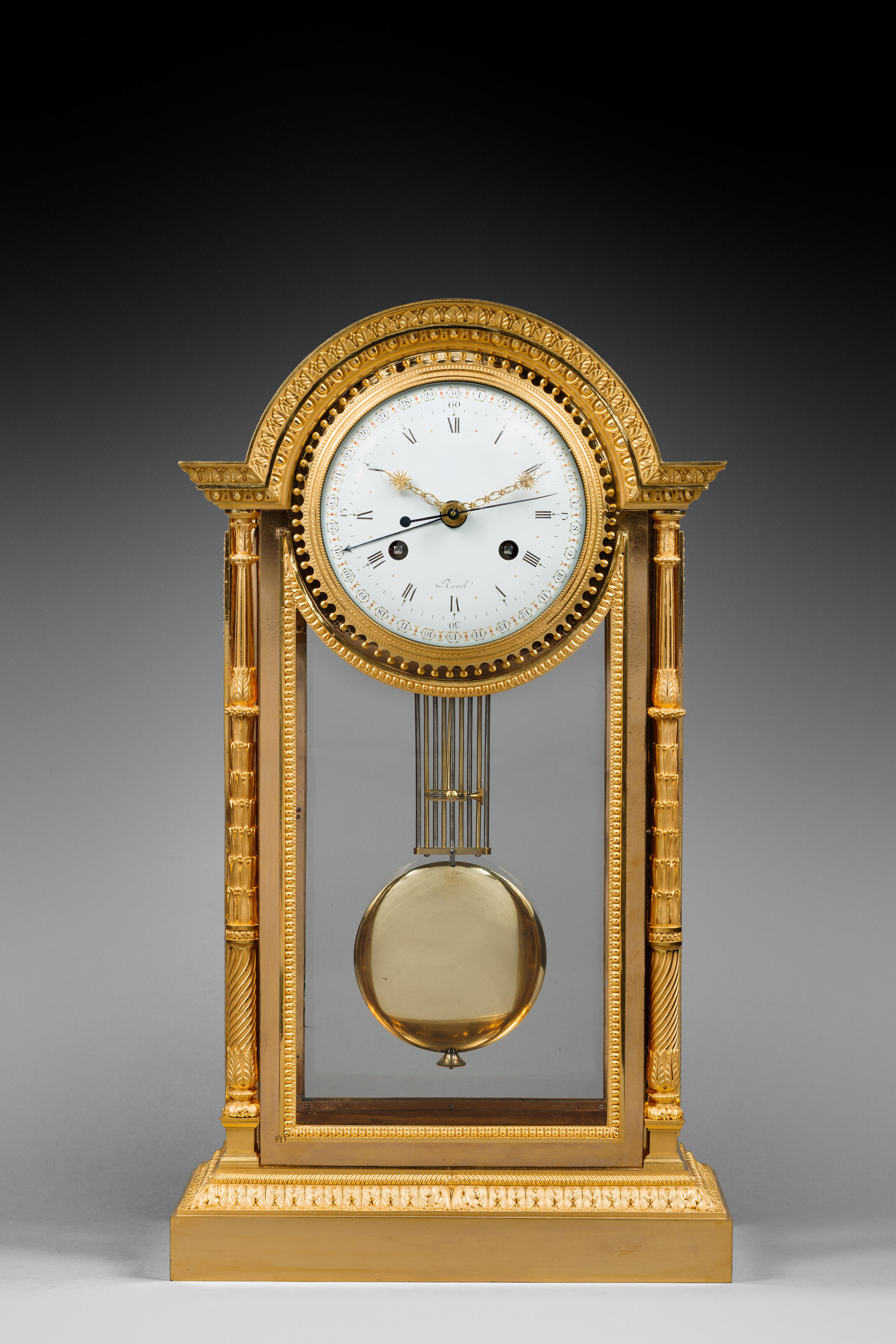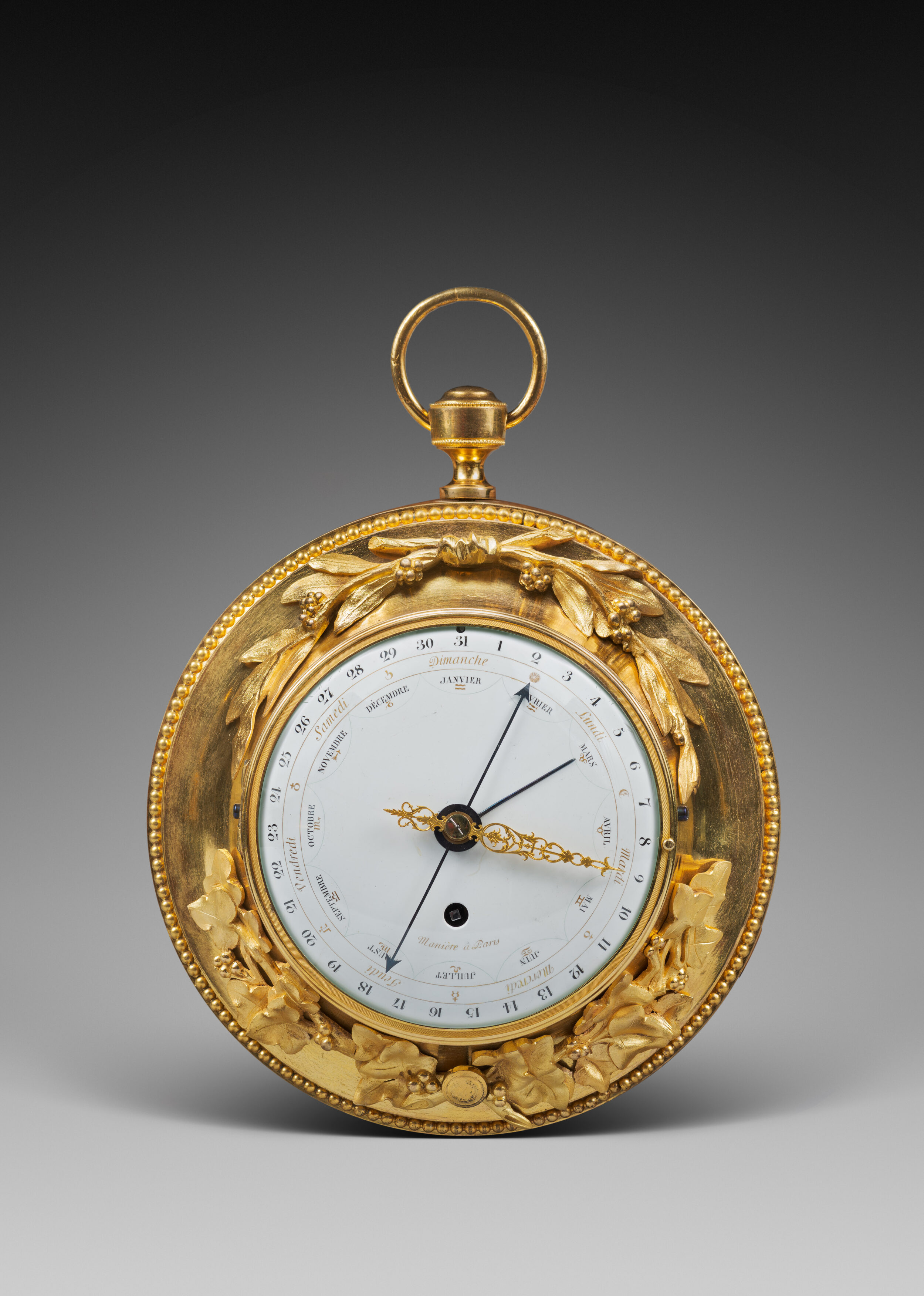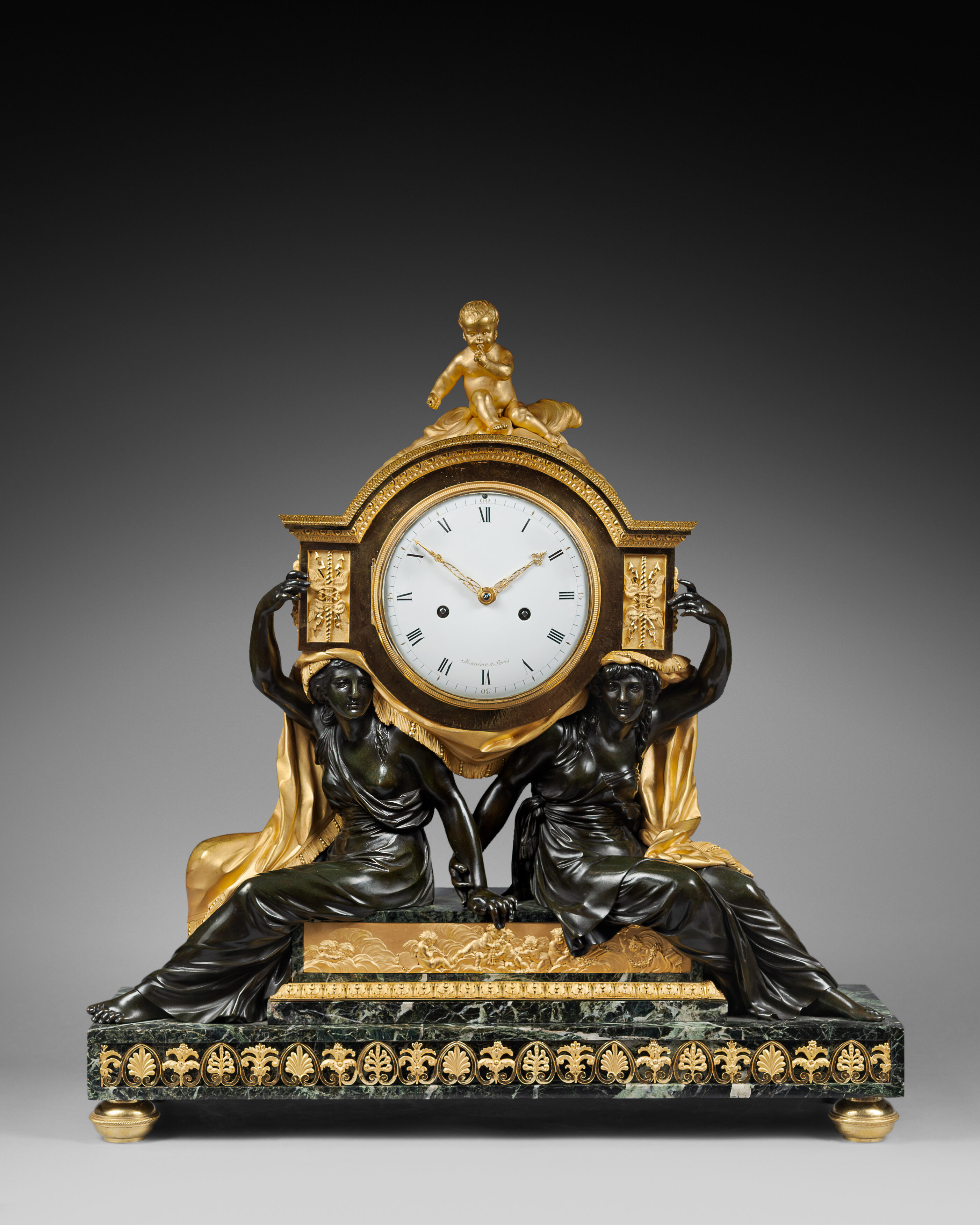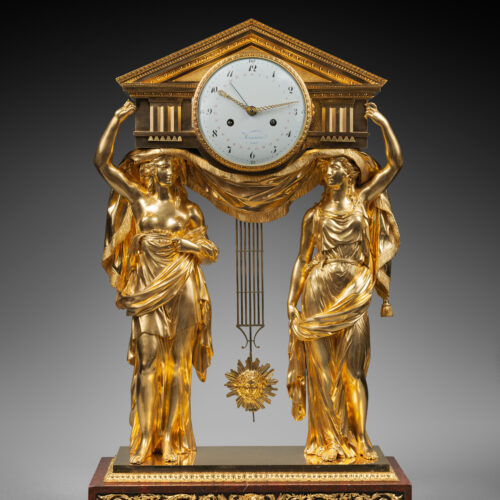Important Mantel Clock with Date, in Italian Red Griotte Marble and Matte or Burnished Gilt Bronze
“The Large Pediment”

Dial signed “Maniere à Paris” by clockmaker Charles-Guillaume Manière
Case attributed to Bronze-Caster François Rémond
Probably made under the supervision of The Daguerre & Lignereux Firm
Paris, late Louis XVI period, circa 1790
BIBLIOGRAPHY:
– Christian Baulez, “Les bronziers Gouthière, Thomire et Rémond”, in Louis-Simon Boizot (1743-1809), Sculpteur du roi et directeur de l’atelier de sculpture à la Manufacture de Sèvres, Musée Lambinet, Versailles, 2001-2002.
The circular white enamel dial, signed “Maniere à Paris”, indicates the hours, the fifteen-minute intervals, and the date by means of three hands, two of which are made of pierced gilt bronze. The hour and half hour striking movement is housed in a case made of finely chased gilt bronze with matte and burnished finishing and Italian red griotte marble. The bezel, adorned with a leaf frieze, is fitted within a triangular classical pediment that is decorated with a pattern of alternating leaves, water leaves, and egg-and-dart motifs. The entablature features triglyph and teardrop motifs. The case is supported on the heads of two magnificent female figures who are dressed in classical garb; above their heads a fringed drapery follows the lower curve of the dial. Between the two figures hangs the pendulum attached by a silk thread suspension, whose bob is adorned with a sun mask. The quadrangular red griotte marble base is decorated with an acanthus frieze and reserves that are adorned, on the sides, with interlacing motifs, and on the façade, with a frieze of scrolls and laurel branches, along with children. It is centered by a vase filled with grape vines, flanked by two facing griffons. The clock stands on four feet with gadrooned rings.
The present clock was the fruit of a rare collaboration between some of the most important people working in the French decorative arts during the late 18th century. The standing figures were inspired by candelabra created in the late 1780s by chaser-gilder François Rémond (circa 1747-1812) at the request of the marchands-merciers Dominique Daguerre and Martin-Eloi Lignereux (dealers in luxury art objects). The model was studied in Christian Baulez’s article “Le luminaire de la princesse Kinsky”, in L’Estampille/L’Objet d’Art, n° 247, May 1991, pp. 88-89. The design encountered such success among influential collectors of the time that, several years later, they decided to use the figures again, asking Rémond to include them in the clock known as “The Large Pediment”. That clock was a remarkable esthetic and artistic success. Its composition is perfectly balanced and the quality of its chasing and gilding is exceptional. Nevertheless, the period was not conducive to the sale of such extraordinary pieces, and few examples were produced.
While the exact volume of production of such clocks is not known, only a small number of identical pieces are today, as well as others with some variations in the treatment of the bases and the patinated female figures. Among them, one clock, with a dial signed “Manière” and a gilt bronze base, is illustrated in P. Kjellberg, Encyclopédie de la pendule française du Moyen Age au XXe siècle, Les éditions de l’Amateur, Paris, 1997, p. 331, fig. E. A second example is in the collection of the Duke of Wellington in Stratfield Saye. A third clock, formerly offered by the “Au Balancier de Cristal” gallery, is shown in Tardy, La pendule française des origines à nos jours, 2ème Partie: Du Louis XVI à nos jours, Paris, 1975, p. 397. A fourth example, with a later dial by Ledure, is illustrated in H. Ottomeyer and P. Pröschel, Vergoldete Bronzen, Die Bronzearbeiten des Spätbarock und Klassizismus, Tome II, Munich, 1986, p. 687, fig. 13. A fifth example, formerly in the collection of Jean Feray, was illustrated in Christian Baulez’s article (“Le luminaire de la Princesse Kinsky”, L’Estampille/L’Objet d’art, n° 247, May 1991, p. 90). One further such clock, with a later dial signed “Lenoble”, was lent in 2014 to the Frick Collection by Horace Wood Brock, for the exhibition Precision and Splendor: Clocks and Watches at the Frick Collection.
Charles-Guillaume Hautemanière (? - 1834)
Charles-Guillaume Hautemanière, known as Manière (mort à Paris en 1834) is one of the most important Parisian clockmakers of the late 18th and early 19th centuries, he became a Master on May 1, 1778, and opened a workshop in the rue du Four-Saint-Honoré. He immediately became famous among connoisseurs of fine horology. Throughout his career, Manière sourced his clock cases from the best Parisian bronze casters and chasers, including Pierre-Philippe Thomire, François Rémond, Edmé Roy and Claude Galle. Marchands-merciers such as Dominique Daguerre and Martin-Eloi Lignereux called upon him to make clocks for the most influential collectors of the time, including the Prince de Salm, the banker Perregaux and the financier Micault de Courbeton, all three of whom were collectors of fine and rare horological pieces. Today, his clocks are found in the most important international private and public collections, including the Hermitage Museum in Saint Petersburg, the Musée national du château de Fontainebleau, the Quirinal Palace in Rome, the Nissim de Camondo Museum in Paris and the Musée national du château de Versailles et des Trianons.
Discover our entire collection of luxury clocks for sale on La Pendulerie Paris.
François Rémond (circa 1747 - 1812)
Along with Pierre Gouthière, he was one of the most important Parisian chaser-gilders of the last third of the 18th century. He began his apprenticeship in 1763 and became a master chaser-gilder in 1774. His great talent quickly won him a wealthy clientele, including certain members of the Court. Through the marchand-mercier Dominique Daguerre, François Rémond was involved in furnishing the homes of most of the important collectors of the late 18th century, supplying them with exceptional clock cases, firedogs, and candelabra. These elegant and innovative pieces greatly contributed to his fame.
Dominique Daguerre is the most important marchand-mercier (i.e. merchant of luxury objects) of the last quarter of the 18th century. Little is known about the early years of his career; he appears to have begun to exercise his profession around 1772, the year he went into partnership with Philippe-Simon Poirier (1720-1785), the famous marchand-mercier who began using porcelain plaques from the Manufacture royale de Sèvres to adorn pieces of furniture. When Poirier retired around 1777-1778, Daguerre took over the shop in the rue du Faubourg Saint-Honoré, keeping the name “La Couronne d’Or”. He retained his predecessor’s clientele, and significantly increased the shop’s activity within just a few years. He played an important role in the renewal of the Parisian decorative arts, working with the finest cabinetmakers of the day, including Adam Weisweiler, Martin Carlin and Claude-Charles Saunier, cabinetmaker of the Garde-Meuble de la Couronne, Georges Jacob, the bronziers and chaser-gilders Pierre-Philippe Thomire and François Rémond, and the clockmaker Renacle-Nicolas Sotiau. A visionary merchant who brought the level of French luxury goods to its highest point, Daguerre settled in England in the early 1780’s, having gone into partnership with Martin-Eloi Lignereux, who remained in charge of the Paris shop. In London, where he enjoyed the patronage of the Prince Regent (the future King George IV), Daguerre actively participated in the furnishing and decoration of Carlton House and the Brighton Pavilion. Taking advantage of his extensive network of Parisian artisans, he imported most of the furniture, chairs, mantelpieces, bronze furnishings, and art objects from France, billing over 14500£, just for 1787. Impressed by Daguerre’s talent, several British aristocrats, called on his services as well. Count Spencer engaged him for the decoration of Althorp, where Daguerre worked alongside architect Henry Holland (1745-1806). In Paris, Daguerre and his partner Lignereux continued to supply influential connoisseurs and to deliver magnificent pieces of furniture to the Garde-Meuble de la Couronne, which were placed in the apartments of Louis XVI and Marie-Antoinette. Daguerre retired in 1793, no doubt deeply affected by the French Revolution and the loss of many of his most important clients.
Martin-Éloi Lignereux (1751 - 1809)
Martin-Eloi Lignereux was one of the most important marchand-merciers (merchants of luxury objects) of the last quarter of the 18th century and the early years of the following century. On April 1, 1787, he went into partnership with Dominique Daguerre, thus becoming the Parisian representative of the Daguerre & Lignereux firm, which was established at 85, rue Saint-Honoré. After Daguerre’s retirement in 1793, he continued to run the firm with great success, while conserving his predecessor’s clientele and playing an important role in the renewal of contemporary Parisian decorative art. In 1801, he was awarded a gold medal at the Exhibition of the Products of Industry, where it was noted that “in the opinion of all observers, the furniture made by Citizen Lignereux is remarkable for its elegance and lavish embellishments, for the choice of the appropriate form for each piece, and finally, for the exactness and high-quality finishing of both the interiors and the exteriors”. Several years previously, his daughter Adélaïde-Anne had married the renowned Parisian cabinetmaker François-Honoré-Georges Jacob, known as Jacob-Desmalter. In 1804 Lignereux retired, selling his business to the bronze caster Pierre-Philippe Thomire. During his active years, Lignereux worked for the most influential collectors of the day, including the Duke d’Aumont-Valentinois, Queen Marie-Antoinette, the Count d’Artois (brother of King Louis XVI), the Baron de Breteuil, the Prince of Wales (future King George IV of England), Czar Paul I of Russia, and Napoleon Bonaparte.
